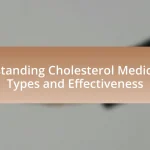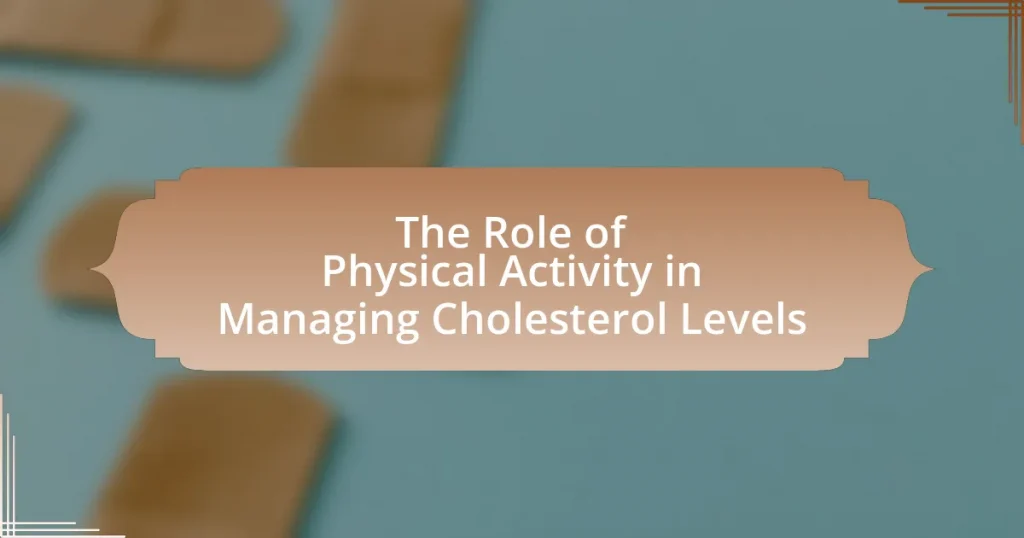The article focuses on the critical role of physical activity in managing cholesterol levels, emphasizing how regular exercise can increase high-density lipoprotein (HDL) cholesterol while lowering low-density lipoprotein (LDL) cholesterol. It outlines the types of physical activities most effective for cholesterol management, such as aerobic and resistance training, and discusses the impact of exercise intensity on lipid profiles. Additionally, the article highlights the importance of maintaining healthy cholesterol levels for overall cardiovascular health and provides practical guidelines for incorporating physical activity into daily routines to achieve optimal cholesterol management.

What is the role of physical activity in managing cholesterol levels?
Physical activity plays a crucial role in managing cholesterol levels by increasing high-density lipoprotein (HDL) cholesterol and lowering low-density lipoprotein (LDL) cholesterol. Regular exercise, such as aerobic activities, has been shown to improve lipid profiles; for instance, a study published in the Journal of the American College of Cardiology found that individuals engaging in moderate to vigorous physical activity can experience a significant reduction in LDL cholesterol levels and an increase in HDL cholesterol levels. This effect is attributed to enhanced metabolism and improved cardiovascular health, which collectively contribute to better cholesterol management.
How does physical activity influence cholesterol levels?
Physical activity positively influences cholesterol levels by increasing high-density lipoprotein (HDL) cholesterol and lowering low-density lipoprotein (LDL) cholesterol. Engaging in regular aerobic exercise, such as brisk walking or cycling, has been shown to raise HDL levels, which helps remove LDL cholesterol from the bloodstream. A study published in the Journal of the American College of Cardiology found that individuals who participated in moderate to vigorous physical activity had significantly higher HDL levels compared to sedentary individuals. Additionally, the American Heart Association recommends at least 150 minutes of moderate-intensity exercise per week to effectively manage cholesterol levels.
What types of physical activity are most effective for cholesterol management?
Aerobic exercise and resistance training are the most effective types of physical activity for cholesterol management. Aerobic exercises, such as brisk walking, running, cycling, and swimming, can help lower LDL (bad) cholesterol and raise HDL (good) cholesterol levels. Studies indicate that engaging in at least 150 minutes of moderate-intensity aerobic activity per week can significantly improve lipid profiles. Resistance training, including weight lifting and bodyweight exercises, also contributes to cholesterol management by enhancing muscle mass and metabolic rate, which can lead to better overall lipid levels. Research published in the Journal of the American Heart Association found that a combination of aerobic and resistance training is optimal for improving cholesterol levels and overall cardiovascular health.
How does the intensity of exercise affect cholesterol levels?
The intensity of exercise significantly affects cholesterol levels, with higher intensity workouts generally leading to greater improvements in lipid profiles. Engaging in vigorous physical activity can increase high-density lipoprotein (HDL) cholesterol, often referred to as “good” cholesterol, while simultaneously reducing low-density lipoprotein (LDL) cholesterol and triglycerides. A study published in the Journal of the American College of Cardiology found that individuals who participated in high-intensity interval training experienced a notable increase in HDL levels compared to those who engaged in moderate-intensity exercise. This evidence supports the conclusion that higher exercise intensity is associated with more favorable cholesterol levels.
Why is managing cholesterol levels important for overall health?
Managing cholesterol levels is crucial for overall health because high cholesterol can lead to cardiovascular diseases, including heart attacks and strokes. Elevated levels of low-density lipoprotein (LDL) cholesterol contribute to the buildup of plaque in arteries, which narrows them and restricts blood flow. According to the American Heart Association, maintaining healthy cholesterol levels can reduce the risk of heart disease by up to 30%. Regular physical activity is a key factor in managing cholesterol, as it can help raise high-density lipoprotein (HDL) cholesterol, the “good” cholesterol, while lowering LDL cholesterol.
What are the risks associated with high cholesterol levels?
High cholesterol levels significantly increase the risk of cardiovascular diseases, including heart attacks and strokes. Elevated low-density lipoprotein (LDL) cholesterol can lead to the buildup of plaques in arteries, a condition known as atherosclerosis, which narrows blood vessels and restricts blood flow. According to the American Heart Association, individuals with high cholesterol are twice as likely to develop heart disease compared to those with normal levels. Additionally, high cholesterol can contribute to hypertension and peripheral artery disease, further compounding cardiovascular risks.
How does cholesterol impact cardiovascular health?
Cholesterol significantly impacts cardiovascular health by influencing the formation of plaques in arteries, which can lead to atherosclerosis. High levels of low-density lipoprotein (LDL) cholesterol are associated with an increased risk of heart disease, as they contribute to the buildup of fatty deposits in arterial walls. According to the American Heart Association, elevated LDL cholesterol levels can double the risk of heart disease. Conversely, high-density lipoprotein (HDL) cholesterol helps remove LDL cholesterol from the bloodstream, thus reducing cardiovascular risk. Maintaining a balance between these types of cholesterol is crucial for heart health.

What are the mechanisms by which physical activity affects cholesterol levels?
Physical activity affects cholesterol levels primarily through the enhancement of lipoprotein metabolism and the promotion of weight management. Regular exercise increases the activity of enzymes that help transport cholesterol from the bloodstream to the liver for excretion, thereby reducing low-density lipoprotein (LDL) cholesterol, often referred to as “bad” cholesterol. Additionally, physical activity raises high-density lipoprotein (HDL) cholesterol, known as “good” cholesterol, which helps remove LDL cholesterol from the arteries. Studies have shown that individuals engaging in moderate to vigorous physical activity can experience a significant increase in HDL levels and a decrease in LDL levels, contributing to improved cardiovascular health. For instance, a meta-analysis published in the Journal of the American College of Cardiology found that aerobic exercise can lead to a 5-10% reduction in LDL cholesterol and a 3-10% increase in HDL cholesterol.
How does exercise promote the increase of HDL cholesterol?
Exercise promotes the increase of HDL cholesterol by enhancing the body’s lipid metabolism and improving insulin sensitivity. Physical activity stimulates the production of enzymes that facilitate the transport of cholesterol from the arteries to the liver, where it is processed and removed from the bloodstream. Studies have shown that regular aerobic exercise, such as running or cycling, can lead to a significant increase in HDL levels, with research indicating that individuals engaging in moderate to vigorous exercise can experience HDL increases of 5% to 10%. This effect is attributed to the positive influence of exercise on body composition and the reduction of visceral fat, which is linked to lower HDL levels.
What role does physical activity play in lowering LDL cholesterol?
Physical activity plays a significant role in lowering LDL cholesterol levels. Engaging in regular exercise can help increase the size of LDL particles, making them less harmful, and can also enhance the body’s ability to metabolize fats, leading to lower overall LDL cholesterol levels. Research indicates that moderate-intensity aerobic exercise, such as brisk walking or cycling, can reduce LDL cholesterol by approximately 5% to 10% when performed consistently over time. This effect is supported by studies, including one published in the Journal of the American College of Cardiology, which found that individuals who engaged in regular physical activity had significantly lower LDL cholesterol levels compared to sedentary individuals.
How does exercise affect triglyceride levels?
Exercise lowers triglyceride levels by enhancing the body’s ability to metabolize fats. Regular physical activity increases the activity of enzymes that help break down triglycerides, leading to reduced levels in the bloodstream. Studies indicate that moderate to vigorous exercise can decrease triglyceride levels by 20-30% in individuals with elevated levels. For instance, a study published in the Journal of the American College of Cardiology found that individuals who engaged in regular aerobic exercise experienced significant reductions in triglyceride levels compared to sedentary individuals.
What physiological changes occur in the body due to regular physical activity?
Regular physical activity induces several physiological changes in the body, including improved cardiovascular function, enhanced metabolic rate, and better lipid profiles. These changes occur as the heart becomes more efficient, pumping blood with less effort, which lowers resting heart rate and blood pressure. Additionally, regular exercise increases the body’s ability to utilize fat as a fuel source, leading to a reduction in body fat percentage.
Moreover, physical activity positively affects cholesterol levels by increasing high-density lipoprotein (HDL) cholesterol, often referred to as “good” cholesterol, while simultaneously lowering low-density lipoprotein (LDL) cholesterol, or “bad” cholesterol. Research indicates that engaging in moderate-intensity aerobic exercise for at least 150 minutes per week can lead to significant improvements in lipid profiles, thereby reducing the risk of cardiovascular diseases.
How does physical activity improve lipid metabolism?
Physical activity improves lipid metabolism by enhancing the body’s ability to oxidize fatty acids and regulate lipid levels. Regular exercise increases the activity of enzymes involved in lipid breakdown, such as lipoprotein lipase, which facilitates the uptake of fatty acids into muscle cells for energy. Additionally, physical activity promotes the conversion of excess carbohydrates into fatty acids, which can then be utilized during exercise, thereby reducing circulating triglyceride levels. Studies have shown that individuals who engage in consistent aerobic exercise experience significant reductions in total cholesterol and low-density lipoprotein (LDL) cholesterol, while high-density lipoprotein (HDL) cholesterol levels often increase. For instance, a meta-analysis published in the Journal of Clinical Lipidology found that aerobic exercise significantly lowers triglycerides and LDL cholesterol while raising HDL cholesterol, demonstrating the beneficial effects of physical activity on lipid metabolism.
What impact does exercise have on body weight and fat distribution?
Exercise significantly impacts body weight and fat distribution by promoting weight loss and altering body composition. Regular physical activity increases energy expenditure, which can lead to a caloric deficit necessary for weight loss. Studies show that aerobic exercise, such as running or cycling, effectively reduces visceral fat, which is linked to various health risks, including high cholesterol levels. For instance, a meta-analysis published in the Journal of Obesity found that individuals engaging in regular aerobic exercise experienced a significant reduction in body fat percentage and waist circumference, indicating improved fat distribution. Therefore, exercise not only aids in weight management but also contributes to healthier fat distribution, which is crucial for overall health and cholesterol management.

What are the recommended guidelines for physical activity to manage cholesterol levels?
To manage cholesterol levels, adults should engage in at least 150 minutes of moderate-intensity aerobic exercise or 75 minutes of vigorous-intensity exercise each week, as recommended by the American Heart Association. This level of physical activity can help raise high-density lipoprotein (HDL) cholesterol, which is beneficial for heart health, while also lowering low-density lipoprotein (LDL) cholesterol and triglycerides. Studies indicate that consistent aerobic exercise, such as brisk walking, cycling, or swimming, can lead to significant improvements in lipid profiles, thereby reducing the risk of cardiovascular disease.
How much physical activity is needed to see improvements in cholesterol levels?
To see improvements in cholesterol levels, individuals should engage in at least 150 minutes of moderate-intensity aerobic exercise per week. This recommendation is supported by the American Heart Association, which states that regular physical activity can help raise high-density lipoprotein (HDL) cholesterol and lower low-density lipoprotein (LDL) cholesterol and triglycerides. Studies have shown that consistent aerobic exercise, such as brisk walking or cycling, can lead to significant changes in lipid profiles, contributing to better cardiovascular health.
What types of exercises should be included in a cholesterol management plan?
Aerobic exercises, strength training, and flexibility exercises should be included in a cholesterol management plan. Aerobic exercises, such as brisk walking, jogging, cycling, and swimming, are effective in lowering LDL cholesterol and raising HDL cholesterol levels. Research indicates that engaging in at least 150 minutes of moderate-intensity aerobic activity per week can significantly improve cholesterol profiles. Strength training, performed at least twice a week, helps build muscle mass and can contribute to overall metabolic health, which is beneficial for cholesterol management. Flexibility exercises, such as yoga or stretching, enhance overall physical fitness and can support adherence to a regular exercise routine, indirectly benefiting cholesterol levels.
How often should one engage in physical activity for optimal cholesterol management?
To achieve optimal cholesterol management, individuals should engage in physical activity at least 150 minutes of moderate-intensity aerobic exercise per week, or 75 minutes of vigorous-intensity exercise. This recommendation is supported by the American Heart Association, which states that regular physical activity can help lower LDL cholesterol and raise HDL cholesterol levels. Additionally, studies indicate that consistent exercise contributes to overall cardiovascular health, further reinforcing the importance of maintaining an active lifestyle for cholesterol management.
What barriers might individuals face in incorporating physical activity into their routine?
Individuals may face several barriers in incorporating physical activity into their routine, including time constraints, lack of motivation, and limited access to facilities. Time constraints often arise from busy work schedules and family responsibilities, making it difficult to prioritize exercise. A study published in the Journal of Physical Activity and Health found that over 60% of adults cite lack of time as a significant barrier to regular physical activity. Lack of motivation can stem from various factors, such as low self-efficacy or previous negative experiences with exercise, which can hinder individuals from starting or maintaining an active lifestyle. Additionally, limited access to safe and affordable exercise facilities, particularly in low-income neighborhoods, can restrict opportunities for physical activity, as highlighted by research from the American Journal of Preventive Medicine, which indicates that access to recreational facilities is positively correlated with higher levels of physical activity.
How can individuals overcome common obstacles to regular exercise?
Individuals can overcome common obstacles to regular exercise by setting realistic goals, creating a structured schedule, and finding enjoyable activities. Setting achievable goals helps maintain motivation and provides a clear path to follow. A structured schedule, such as dedicating specific days and times for workouts, can help integrate exercise into daily routines. Engaging in enjoyable activities increases adherence to exercise, making it less of a chore and more of a rewarding experience. Research indicates that individuals who enjoy their exercise are more likely to stick with it long-term, thus effectively managing cholesterol levels through consistent physical activity.
What strategies can help maintain motivation for physical activity?
To maintain motivation for physical activity, setting specific, achievable goals is essential. Research indicates that individuals who establish clear objectives are more likely to adhere to their exercise routines, as these goals provide direction and a sense of accomplishment. Additionally, incorporating variety into workouts can prevent boredom and sustain interest; studies show that diverse activities enhance enjoyment and commitment to physical activity. Social support also plays a crucial role; engaging with friends or joining exercise groups can increase accountability and motivation, as individuals are more likely to stick to their routines when they feel supported. Lastly, tracking progress through apps or journals can reinforce motivation by visually demonstrating improvements over time, which is backed by evidence that self-monitoring leads to better adherence to physical activity.
What practical tips can help individuals effectively manage cholesterol levels through physical activity?
Engaging in regular physical activity is essential for effectively managing cholesterol levels. Individuals should aim for at least 150 minutes of moderate-intensity aerobic exercise each week, such as brisk walking or cycling, which has been shown to lower LDL (bad cholesterol) and raise HDL (good cholesterol). Incorporating strength training exercises at least twice a week can also contribute to overall cardiovascular health by improving muscle mass and metabolism.
Research indicates that consistent physical activity can lead to a 5-10% reduction in total cholesterol levels, as noted in a study published in the Journal of the American Heart Association. Additionally, activities like swimming, jogging, or dancing not only enhance cardiovascular fitness but also promote weight management, which is crucial since excess body weight can negatively impact cholesterol levels.










